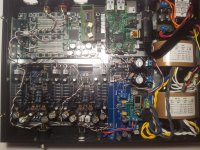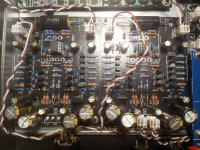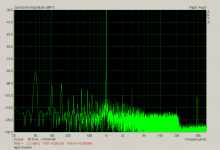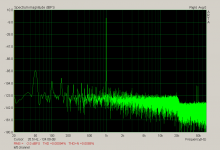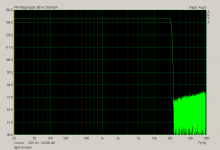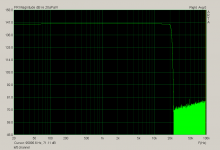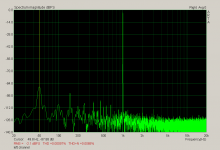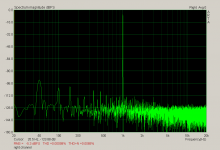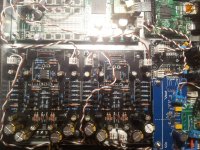The cons you mentioned sound like a list of most of my amps before burn in. I'd say run it a few days straight.
Yes. It was already changing by hour 3. The cymbals had more ring to them. It'll take awhile.
Thanks!
Tried AD8610 Op Amps
Following my experiment trying to get Sparko's SS3601 discreet op amps to behave in Sapphire 30.f (with the circuit mod described further back in this thread, they sounded great, but the output offset proved to be untameable), I put the OPA134's back in and I must say; I was disappointed in their sound after hearing something better. Today I mounted a pair of AD8610's on Brown Dog adapters and popped them into the sockets. Output offset is .3mV on one channel, -3.5mV on the other, a closer channel match than I could get with either pair of OPA134's I have (they were about 15mV difference between channels, I wonder why would that be?).
To my ears the AD8610's are an improvement over the 134's, I'm happy again.
I also have a pair of OPA827's to try - also on Brown Dog adapters.
Following my experiment trying to get Sparko's SS3601 discreet op amps to behave in Sapphire 30.f (with the circuit mod described further back in this thread, they sounded great, but the output offset proved to be untameable), I put the OPA134's back in and I must say; I was disappointed in their sound after hearing something better. Today I mounted a pair of AD8610's on Brown Dog adapters and popped them into the sockets. Output offset is .3mV on one channel, -3.5mV on the other, a closer channel match than I could get with either pair of OPA134's I have (they were about 15mV difference between channels, I wonder why would that be?).
To my ears the AD8610's are an improvement over the 134's, I'm happy again.
I also have a pair of OPA827's to try - also on Brown Dog adapters.
I've got several discrete, a couple of hybrid, and a few 8-pin opamps to go through. But I want to wait until the amp gets a hundred or so hours on it.
Though after 24-hours of continuous playing, it sounds more balanced and the tightness is gone.
Offset voltage after 24-hours - Left -5mv, right -1mv.
I did notice that on the bench, once the OPA134's offset was zeroed out, dropping in some non-fet discrete opamps, like the JE-918 and FiveFish's DOA-17 was plug-n-play with no offset adjustment.
Though after 24-hours of continuous playing, it sounds more balanced and the tightness is gone.
Offset voltage after 24-hours - Left -5mv, right -1mv.
I did notice that on the bench, once the OPA134's offset was zeroed out, dropping in some non-fet discrete opamps, like the JE-918 and FiveFish's DOA-17 was plug-n-play with no offset adjustment.
Disfunctional, how about reporting back when you've tested all the op-amps and let us know how each sounds?
I've never messed around with any discrete op-amps. That DOA-17 is affordable in kit form, but has some odd pin configuration.
I'm still curious about its and the others sound quality, though.
Thanks...
I've never messed around with any discrete op-amps. That DOA-17 is affordable in kit form, but has some odd pin configuration.
I'm still curious about its and the others sound quality, though.
Thanks...
Lets not go there okay? I'm totally fine with people just reporting what they hear. I myself do it all the time.
Though it would be a good idea to let it burn in fully before you change something. I'd also suggest doing the comparison twice (abab) so you hear the difference going back to the original, and then back to the new again as a final check. I could get a pretty good feel for the difference between, say, OPA134 and NE5532 that way, though I must admit it barely of any consequence. i.e. enough to detect but not really enough to care about.
Though it would be a good idea to let it burn in fully before you change something. I'd also suggest doing the comparison twice (abab) so you hear the difference going back to the original, and then back to the new again as a final check. I could get a pretty good feel for the difference between, say, OPA134 and NE5532 that way, though I must admit it barely of any consequence. i.e. enough to detect but not really enough to care about.
I'm with Richard on this one. Blind A/B has some merit. But I've have many decades of dealing with my biases and listening to lots of different systems. I prefer to listen to something for an extended period before switching it out, unless it's just noticeably not cutting it.
And some of the opamps might sound better without the 47pf across R4. But it's rather painful to be tuning the circuit for each opamp that cap is on the bottom of the boards. So it'll stay.
And one opamp that's going to take awhile to complete is the Cascode from Ramshackle Recording. It's interesting because it doesn't have a differential front-end, rather it has a 2SK170 FET cascoded by a 2N2484. However, I'm still waiting for the PWBs to arrive.
And some of the opamps might sound better without the 47pf across R4. But it's rather painful to be tuning the circuit for each opamp that cap is on the bottom of the boards. So it'll stay.
And one opamp that's going to take awhile to complete is the Cascode from Ramshackle Recording. It's interesting because it doesn't have a differential front-end, rather it has a 2SK170 FET cascoded by a 2N2484. However, I'm still waiting for the PWBs to arrive.
I took Mooly's Listening Test last Sunday, a bit late to vote. What I found interesting was that I grouped the LM833, NE5532, and LM4562 together with a preference for the LM833 strictly on the extreme highs. Even with the blind listening, it was easy enough to tell the differences in the sound of the different opamps.
The Sapphire with the SG-SOA-2 DOA is very revealing - notes are clearly delineated and there is space between them. Nothing is smeared together. However, the Schitt Modi 2 may have a bit too much high frequency energy. Last night I setup the Denon DVD-3300 and a toslink to the Modi 2, but ended up using the analog out from the Denon, even though it was more 2-D. It was much easier to get into the music and the detail was there.
The bass slam from CD through the Denon didn't have as much impact as playing the same flac through USB from the computer. But the detail was there, both through the toslink and the analog out. The bass goes very deep, vocals are intimate, there's no noise - hum on recordings can be heard, analog tape noise, Eric Clapton's slight lisp and traces of English accent are present in detail I'd missed before.
An interesting aspect is the sense of power the Sapphire brings to headphone listening. The other headphone amps I listen to are not all that bad, but they don't provide that sense of power. The Sapphire with a DOA is quite the headphone amp. I look forward to swapping in opamps.
The Sapphire with the SG-SOA-2 DOA is very revealing - notes are clearly delineated and there is space between them. Nothing is smeared together. However, the Schitt Modi 2 may have a bit too much high frequency energy. Last night I setup the Denon DVD-3300 and a toslink to the Modi 2, but ended up using the analog out from the Denon, even though it was more 2-D. It was much easier to get into the music and the detail was there.
The bass slam from CD through the Denon didn't have as much impact as playing the same flac through USB from the computer. But the detail was there, both through the toslink and the analog out. The bass goes very deep, vocals are intimate, there's no noise - hum on recordings can be heard, analog tape noise, Eric Clapton's slight lisp and traces of English accent are present in detail I'd missed before.
An interesting aspect is the sense of power the Sapphire brings to headphone listening. The other headphone amps I listen to are not all that bad, but they don't provide that sense of power. The Sapphire with a DOA is quite the headphone amp. I look forward to swapping in opamps.
Swapped in the OPA134P last night. Set the offset to under 1 mv on both channels. The DIP to DOA adapters had on board .1 uFd ceramic NPO/COG bypass caps to ground from each power pin. Just a socket and DOA pins.
The OPA134P hit hard on a major bias of mine - I prefer accuracy to musicality. The OPA134P is very musical. It's euphoric. So much so, it was like being fed sugar syrup for the hour plus of listening.
There was less space between the notes. There was more speed to the music, more harmonics or emphasis, especially in the mid-bass. The bass didn't seem to go quite as deep. It was deep, but it was odd in that it seemed that the overtones were more prominent than the fundamental. The echos were longer, the notes had more sustain. There was even more 3-D to the sound space. But, the intimacy with the performer, especially the solo singer was missing.
One track I use is Dire Straits' Telegraph Road. I listen with my eyes closed in order to focus on the music. And I couldn't get into it. The headphone amp became part of the performance. It intruded into the music.
Perhaps I need to burn the opamps in? I can see that with DOAs. But monolithic opamps shouldn't need that.
The OPA134P hit hard on a major bias of mine - I prefer accuracy to musicality. The OPA134P is very musical. It's euphoric. So much so, it was like being fed sugar syrup for the hour plus of listening.
There was less space between the notes. There was more speed to the music, more harmonics or emphasis, especially in the mid-bass. The bass didn't seem to go quite as deep. It was deep, but it was odd in that it seemed that the overtones were more prominent than the fundamental. The echos were longer, the notes had more sustain. There was even more 3-D to the sound space. But, the intimacy with the performer, especially the solo singer was missing.
One track I use is Dire Straits' Telegraph Road. I listen with my eyes closed in order to focus on the music. And I couldn't get into it. The headphone amp became part of the performance. It intruded into the music.
Perhaps I need to burn the opamps in? I can see that with DOAs. But monolithic opamps shouldn't need that.
And one opamp that's going to take awhile to complete is the Cascode from Ramshackle Recording. It's interesting because it doesn't have a differential front-end, rather it has a 2SK170 FET cascoded by a 2N2484. However, I'm still waiting for the PWBs to arrive.
What substitutes are you gonna use in this particular doa?
Thanks,
The OPA134P hit hard on a major bias of mine - I prefer accuracy to musicality. The OPA134P is very musical. It's euphoric. So much so, it was like being fed sugar syrup for the hour plus of listening.
I wouldn't describe it like that, but I definitely hear what you hear in the OPA134. I think of it as airiness, lyricism. Flow. Sweep. Alright, I guess we can settle on "euphoric".
In terms of musicality over accuracy, I picked out the OPA134 over the NE5534 as adding that little extra enjoyment factor into what was already a very accurate-sounding, low noise headphone amp circuit. I do not believe the NE5534 to be more (or less) accurate so much as it presents a slightly different point of view, suitable for a slightly different set of musical tastes.
Last edited:
For my money discrete opamps are a waste of time and mostly badly designed.
Want a really good one ?
The Jensen JE-990
Designed by REAL experts and well documented by Dean Jensen in a few good AES papers
Since National discontinued the LM394 (a totally dumb idea) the 990 is no longer made
But hey, that stupid supermatch pair used SOOOO much precious die space..........sigh
Want a really good one ?
The Jensen JE-990
Designed by REAL experts and well documented by Dean Jensen in a few good AES papers
Since National discontinued the LM394 (a totally dumb idea) the 990 is no longer made
But hey, that stupid supermatch pair used SOOOO much precious die space..........sigh
Back in the early '90s, I spent a lot of time over at a friends house - Apogee Duettas, first Threshold, then Krell amps, solid silver speaker cables, Krell preamp, SOTA turntable with an Ortophon mc cartridge, Ortophon transformer step-up to MM level, and full acoustic room treatment where we spent a lot time getting the imaging correct. I thought it was one of the better systems around.
One summer I took a vacation and visited the Boulder factory up in Colorado, back when they made Boulder amps and pre-amps using the JE-990. In their listening room which was multi-amped, and the speaker system included a pair 30" Electro Voice sub-woofers was when I understood the difference between accuracy and musicality. They also, had spent a lot of time on the room acoustics. And they worked with recording engineers to get everything correct - Boulder amps went into a lot of recording studios at the time. When the system presented a piano 5 feet back in the sound stage, it was 5 feet back in the studio. On the Apogee/Krell system the piano would seem to be closer and go back further, making it bigger.
Both systems were enjoyable to listen to, but I have a personal bias towards accuracy. Others have a bias in the other direction or somewhere in between. It's fine with me either way, I just have a preference.
One summer I took a vacation and visited the Boulder factory up in Colorado, back when they made Boulder amps and pre-amps using the JE-990. In their listening room which was multi-amped, and the speaker system included a pair 30" Electro Voice sub-woofers was when I understood the difference between accuracy and musicality. They also, had spent a lot of time on the room acoustics. And they worked with recording engineers to get everything correct - Boulder amps went into a lot of recording studios at the time. When the system presented a piano 5 feet back in the sound stage, it was 5 feet back in the studio. On the Apogee/Krell system the piano would seem to be closer and go back further, making it bigger.
Both systems were enjoyable to listen to, but I have a personal bias towards accuracy. Others have a bias in the other direction or somewhere in between. It's fine with me either way, I just have a preference.
Last edited:
JE-990 still being made
The JE-990 is still being made. John Hardy makes the JE-990c, and Analog Devices makes the SSM-2212 super-match pair.
Since National discontinued the LM394 (a totally dumb idea) the 990 is no longer made
But hey, that stupid supermatch pair used SOOOO much precious die space..........sigh
The JE-990 is still being made. John Hardy makes the JE-990c, and Analog Devices makes the SSM-2212 super-match pair.
Swapped in a pair of LT1357 DIP-8 opamps last night. I didn't tweak the offset bias, left it as it was for the OPA134s. The offset voltage wondered a bit, but stablized fairly quickly at -8 mv, right channel, and -12 mv left channel. The both varied a bit +/- 2 mv but no real surprises. Cost is twice that of the OPA134.
The sound was more to my liking, though a bit recessed around 60 Hz - the hum on Vanilla Fudge's cover of "Some Velvet Morning" that starts in the right channel then pans to the left, then disappears, wasn't as prominent. There wasn't any space between the notes, but there was a hint of the intimacy that went missing when the SG-SOA-2s were removed.
The LT1357 really brings out the details in a recording. Things that started softly in the background were very clear and more abundant than I can recall from the other opamps. The subtle variances in voices and overtones were more apparent. The music wasn't fast, but more relaxing and pleasant. The bass was well controlled - deep fundamentals, good overtones. The highs were detailed and not harsh. It's an easy opamp to listen to and the Sapphire doesn't become a part of the musical performance.
While there isn't the blackness of silence between the notes that the SG-SOA-2 brought, the LT1357 doesn't get in the way of music and provides more details than the SG-SOA-2.
The sound was more to my liking, though a bit recessed around 60 Hz - the hum on Vanilla Fudge's cover of "Some Velvet Morning" that starts in the right channel then pans to the left, then disappears, wasn't as prominent. There wasn't any space between the notes, but there was a hint of the intimacy that went missing when the SG-SOA-2s were removed.
The LT1357 really brings out the details in a recording. Things that started softly in the background were very clear and more abundant than I can recall from the other opamps. The subtle variances in voices and overtones were more apparent. The music wasn't fast, but more relaxing and pleasant. The bass was well controlled - deep fundamentals, good overtones. The highs were detailed and not harsh. It's an easy opamp to listen to and the Sapphire doesn't become a part of the musical performance.
While there isn't the blackness of silence between the notes that the SG-SOA-2 brought, the LT1357 doesn't get in the way of music and provides more details than the SG-SOA-2.
Finally I've managed to get rjm's kit assembled. My aim was to pack everything in a one box. It's quite dense and messy there, maybe there are some flaws wrt component placement, but I'm quite happy with the final results. Signal path is as follows: rpi (flacs are stored locally on flash)->i2s->dam1021->sapphire. Volume control is done at dac fpga and integrated with mopidy [1], so effectively everything is managed either through web browser or dedicated mpd client. In my case it's mpdroid [2].
This my first diy audio project. Nonetheless I found it quite easy to solder everything on sapphire boards. Power supply is delivered by 2 r-cores with multiple secondaries. I used 15V/0.5A (instead of recommended 12V) for headphone amp. Temperature of bd135/6 packages hits 50C. Other secondaries are used by dac and rpi. As a result I replaced 1000uF 25V Nichicon FW found in the kit with 1000uF 50V Nichicon KW. Z-regs work quite well. One rail of one board gives slightly lower voltage (0.2-0.3V less than the others), but this due to zener diode accuracy. Other z-regs surprisingly give similar output voltages of +/-10.7V IIRC. Opamp feedback resistors: R4=4k7, R3=4k7, R3a=1k2. Usually a higher gain is set for my dt 880 (600ohm).
I let it run for a couple of days before making any judgements. But even after a couple of initial listening hours the most significant impression could be articulated: sapphire delivers power effortlessly, no matter whether acoustic, intimate track or some insanely dense electronic cut is in queue. A very good companion to the r-2r dac. I'm starting to like listening through headphone.
Thank you, rjm!
PS. I've made some measurements using emu-0404, but more for fun and learning than anything else.
[1] https://www.mopidy.com/
[2] https://play.google.com/store/apps/details?id=com.namelessdev.mpdroid&hl=en
This my first diy audio project. Nonetheless I found it quite easy to solder everything on sapphire boards. Power supply is delivered by 2 r-cores with multiple secondaries. I used 15V/0.5A (instead of recommended 12V) for headphone amp. Temperature of bd135/6 packages hits 50C. Other secondaries are used by dac and rpi. As a result I replaced 1000uF 25V Nichicon FW found in the kit with 1000uF 50V Nichicon KW. Z-regs work quite well. One rail of one board gives slightly lower voltage (0.2-0.3V less than the others), but this due to zener diode accuracy. Other z-regs surprisingly give similar output voltages of +/-10.7V IIRC. Opamp feedback resistors: R4=4k7, R3=4k7, R3a=1k2. Usually a higher gain is set for my dt 880 (600ohm).
I let it run for a couple of days before making any judgements. But even after a couple of initial listening hours the most significant impression could be articulated: sapphire delivers power effortlessly, no matter whether acoustic, intimate track or some insanely dense electronic cut is in queue. A very good companion to the r-2r dac. I'm starting to like listening through headphone.
Thank you, rjm!
PS. I've made some measurements using emu-0404, but more for fun and learning than anything else.
[1] https://www.mopidy.com/
[2] https://play.google.com/store/apps/details?id=com.namelessdev.mpdroid&hl=en
Attachments
Although the quality of sound produced by default configuration is satisfactory, I've noticed soundstage is somewhat deteriorated as well as lower registers are slightly sluggish when compared to my integral amp and floor speakers fed by the same dac. So I decided to remove C1 caps from signal path.
I must say this mod kicks sapphire to a new highs when it comes to microdynamic and stereophony attributes of sound reproduction. And that charm of the mids!
btw. I have noticed slightly lower harmonics of household power. Is that really because of these C1 caps?
I must say this mod kicks sapphire to a new highs when it comes to microdynamic and stereophony attributes of sound reproduction. And that charm of the mids!
btw. I have noticed slightly lower harmonics of household power. Is that really because of these C1 caps?
Attachments
Since you are running the DAC directly (?) into the Sapphire, there is probably no need to have the coupling cap C1. Removing it could, I suppose, reduce some power line noise coupling since the DC impedance of the whole input section is lower. The impedance at 50/60 Hz though would be low even with the capacitor so I'm not quite sure what's going on there I admit.
C1 takes a long time to break in as only passing a signal works .. just having the Sapphire powered up has no effect. And replacing the kit C1 with a better audio cap is also recommended.
Thanks very much for your report and the photos. Just so you know, your measurements are mostly showing just the response, distortion, and noise of the input source rather than the Sapphire circuit. Though at -128 dB the noise floor looks about right.
C1 takes a long time to break in as only passing a signal works .. just having the Sapphire powered up has no effect. And replacing the kit C1 with a better audio cap is also recommended.
Thanks very much for your report and the photos. Just so you know, your measurements are mostly showing just the response, distortion, and noise of the input source rather than the Sapphire circuit. Though at -128 dB the noise floor looks about right.
- Home
- Amplifiers
- Headphone Systems
- RJM Audio Sapphire Desktop Headphone Amplifier
